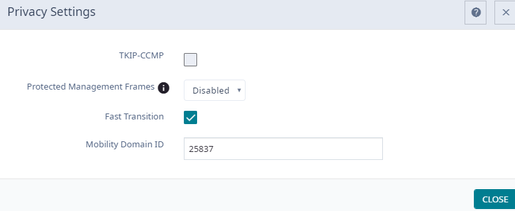- Extreme Networks
- Community List
- Network Management & Authentication
- ExtremeCloud IQ Controller
- Re: 802.11k and FT configuration
- Subscribe to RSS Feed
- Mark Topic as New
- Mark Topic as Read
- Float this Topic for Current User
- Bookmark
- Subscribe
- Mute
- Printer Friendly Page
802.11k and FT configuration
- Mark as New
- Bookmark
- Subscribe
- Mute
- Subscribe to RSS Feed
- Get Direct Link
- Report Inappropriate Content
10-30-2023 09:59 AM
we have a pair of E2122 controllers version 10.6.1.21 configured as active active so mobility is not enabled (based on what i read and what extreme told us it's not necessary in an active active setup).
we have a wpa2-enterprise ssid that was configured about a year or two ago and I was going through some settings and noticed FT is not enabled on this SSID.
i have a fwe questions regarding this.
1) are there any known issues with this enabled?
2) since we dont have mobility enabled, what is the relevance of the mobility domain ? do i need to enable it for FT to work properly? does the mobility domain need to match on both controllers?
I also want to know if extreme recommends enabling 802.11k?
are there any known issues when enabling it? we do have smart RF enabled
one of the things i noticed is it says that enabling this may cause a radio reset. we 5 ssids (one for voice) across multiple sites. this settings is not enabled on any of the ssids? will this cause a radio reset?
Solved! Go to Solution.
- Mark as New
- Bookmark
- Subscribe
- Mute
- Subscribe to RSS Feed
- Get Direct Link
- Report Inappropriate Content
11-06-2023 07:56 AM
Hi
Yes the mobility will need to be the same but you don't need to worry about that as the controller will sync that setting automatically, most customers, just accept the default mobility domain value.
-Gareth
- Mark as New
- Bookmark
- Subscribe
- Mute
- Subscribe to RSS Feed
- Get Direct Link
- Report Inappropriate Content
11-06-2023 04:01 AM
Hi
802.11k and 802.11r are somewhat related.
As far as 802.11r (Fast Transition) is concerned, the mobility setting here is a unique identifier for this 11r domain within the 802.11r protocol, it is totally unrelated to the mobility feature on the controller, there is no inter-dependency. 'Controller' mobility is a legacy feature carried over from the identiFi platform and is typically used whilst migrating from identiFi to XIQ-C, then disabled once migration is complete, it is a method for maintaining session information across >2 controllers, in a 2 controller pair, this information is exchanged via the availability feature.
802.11k provides radio information sent by access points and processed by clients that support it, from that information clients can choose which AP seems to be best for it to (fast) transition to.
Both the AP and the clients must support the protocols for them to work. 802.11r is typically most useful in voice environments where latency roaming becomes noticeable during a call.
Enabling or disabling 11k may cause a radio reset, if you are concerned about that I would only enable these features during a maintenance window, it is recommended to have a consistent 11k configuration for all SSID's on the same radio for reasons mentioned in the help screenshot in your post.
As to whether to enable/disable these protocols, are you having issues with roaming at the moment that you feel such protocols might solve, if not it's probably safe to leave them off. You mentioned you have a voice service, is this using 802.1X or PSK, do your VOIP devices support 11k/r?
HTH
-Gareth
- Mark as New
- Bookmark
- Subscribe
- Mute
- Subscribe to RSS Feed
- Get Direct Link
- Report Inappropriate Content
11-06-2023 05:57 AM
Hello,
Thanks for your reply. We have a PSK SSID just for voice.
We have a lot of users using cell phones (we have a psk SSID just for personal devices) and we have a 802.1X SSID for everything else. I havent heard or noticed any issues I'm just trying to speed up the roaming process as far as clients associating to a better (stronger signal) AP if I could.
So if I want to enable fast transition on the 802.1X SSID, does the mobility domain need to be the same on both controllers? is there any other configuration needed for this to work properly or just check the fast transition box and set the mobility domain?
I may just end up leaving both features off I just wanted to ask the community if it's worth enabling them.
- Mark as New
- Bookmark
- Subscribe
- Mute
- Subscribe to RSS Feed
- Get Direct Link
- Report Inappropriate Content
11-06-2023 07:56 AM
Hi
Yes the mobility will need to be the same but you don't need to worry about that as the controller will sync that setting automatically, most customers, just accept the default mobility domain value.
-Gareth
- Mark as New
- Bookmark
- Subscribe
- Mute
- Subscribe to RSS Feed
- Get Direct Link
- Report Inappropriate Content
11-07-2023 05:49 AM
Thank you


